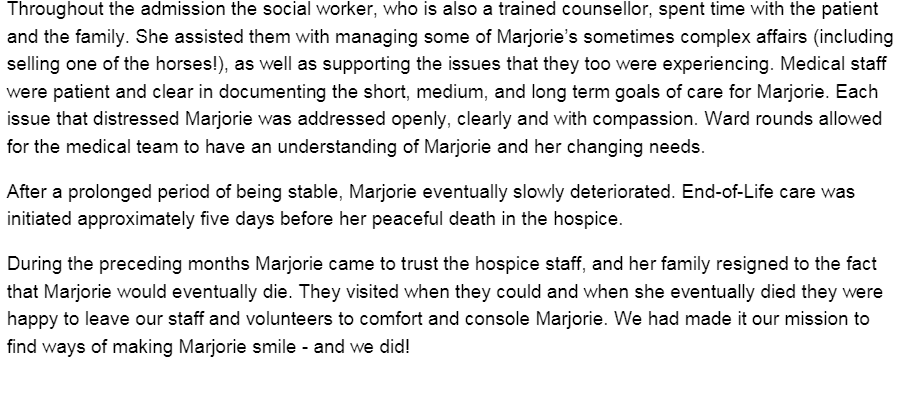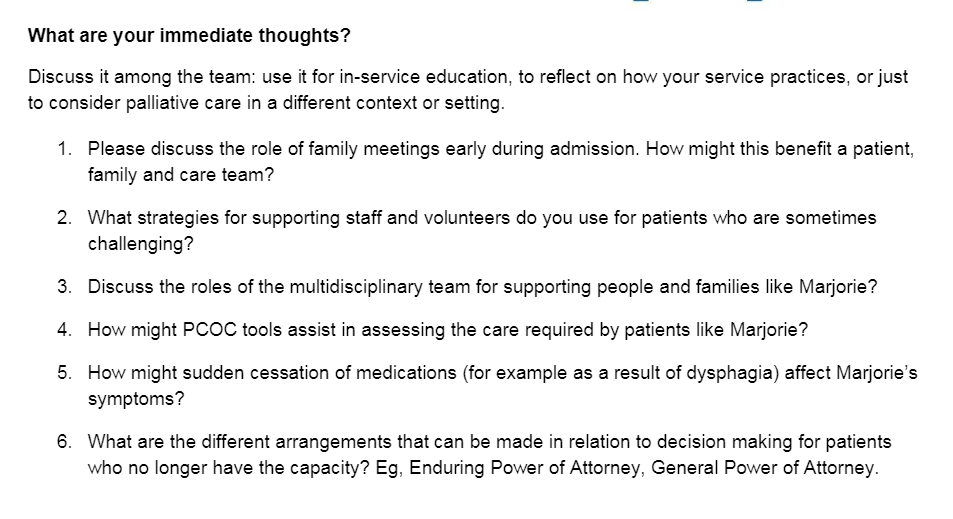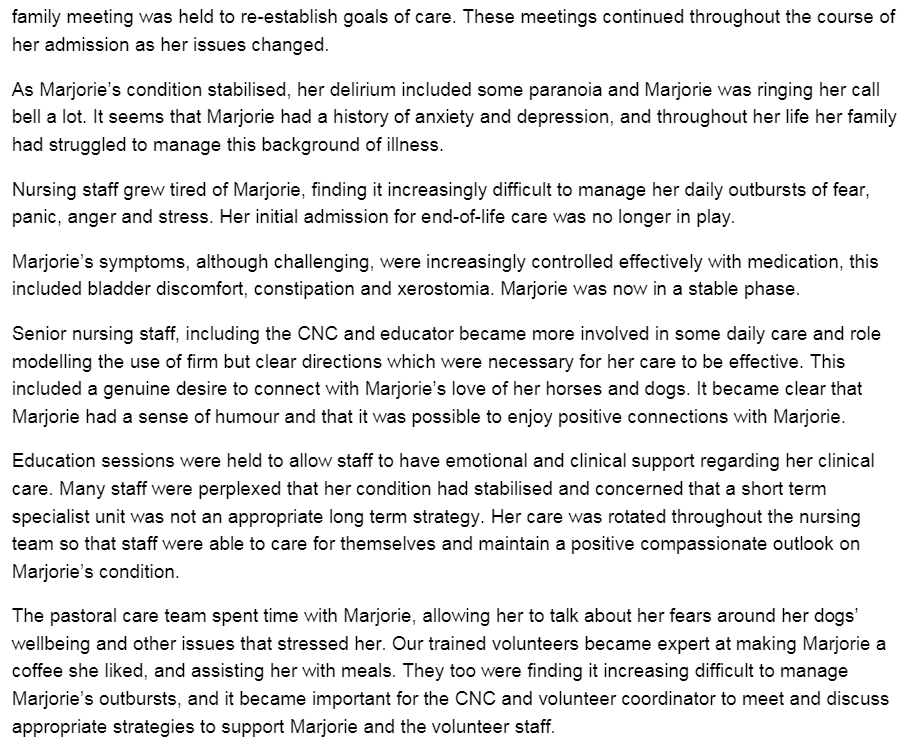Answered step by step
Verified Expert Solution
Question
1 Approved Answer
Marjorie was a 60-year-old woman who came to the hospice after a long and arduous hospital admission. She was a single woman who had





Marjorie was a 60-year-old woman who came to the hospice after a long and arduous hospital admission. She was a single woman who had enjoyed a rural farm life, including managing race horses and a large rural property. Initially she was admitted to a NSW hospital with a Basal Cell Carcinoma that, despite initial surgical intervention, had infiltrated her brain tissue. Following a second surgical intervention she had been in an ICU, where she was intubated and suffering seizures. After a successful extubation and the use of anti convulsants, she was finally released from ICU. Unfortunately following the surgery she also developed a deep intracranial infection that was not resolving. As her condition worsened, her brother requested palliative care consultancy input at the hospital. Marjorie had become unresponsive at the hospital and it was agreed at that point she would be transferred to the hospice for end-of-life care. Marjorie had a range of symptoms which were causing issues. These included ongoing seizure activity, headaches, and a hyperactive delirium. Her pain medication, seizure medications and medications associated with her history of anxiety and depression were reviewed and revised numerous times. Whilst remaining very frail, dependent, and largely symptomatic, her condition stabilised. Her family were her Enduring Power of Attorney and were clear that Marjorie was not for further burdensome interventions, including cannulation, transfer to another acute facility, surgical options or resuscitation. The hospice was the preferred place of death. Her nursing care included; ongoing management of her worsening mobility and associated falls risk issues. Our Physiotherapist and Occupational Therapist reviewed her mobility on a regular basis, 20 www.ibi.15 observing her with transfer use of the MRAT and the PCOC RUG ADL tools she was able to mobilise with a wheelie walker for some time, until she was eventually bed-bound or utilising a sling lifter, lifted into a fall out chair. Marjorie had skin integrity issues due to her increase frailty and continence issues her care needs were modified as her condition deteriorated. Management of these continued to be integral to Marjorie's comfort and care. Her scalp wound was quite purulent and malodourous. Wound care had to accommodate these issues, as well as addressing aesthetic issues and Marjorie being confused was constantly attempting to remove dressing material. Nursing staff utilised a range of head wear to suit Marjorie's needs. Marjorie's family were initially quite relieved that she was in a facility and that her illness was coming to an end, but after a week she awoke from her comatose state. This was challenging for the family. An early Throughout the admission the social worker, who is also a trained counsellor, spent time with the patient and the family. She assisted them with managing some of Marjorie's sometimes complex affairs (including selling one of the horses!), as well as supporting the issues that they too were experiencing. Medical staff were patient and clear in documenting the short, medium, and long term goals of care for Marjorie. Each issue that distressed Marjorie was addressed openly, clearly and with compassion. Ward rounds allowed for the medical team to have an understanding of Marjorie and her changing needs. After a prolonged period of being stable, Marjorie eventually slowly deteriorated. End-of-Life care was initiated approximately five days before her peaceful death in the hospice. During the preceding months Marjorie came to trust the hospice staff, and her family resigned to the fact that Marjorie would eventually die. They visited when they could and when she eventually died they were happy to leave our staff and volunteers to comfort and console Marjorie. We had made it our mission to find ways of making Marjorie smile - and we did! What are your immediate thoughts? Discuss it among the team: use it for in-service education, to reflect on how your service practices, or just to consider palliative care in a different context or setting. 1. Please discuss the role of family meetings early during admission. How might this benefit a patient, family and care team? 2. What strategies for supporting staff and volunteers do you use for patients who are sometimes challenging? 3. Discuss the roles of the multidisciplinary team for supporting people and families like Marjorie? 4. How might PCOC tools assist in assessing the care required by patients like Marjorie? 5. How might sudden cessation of medications (for example as a result of dysphagia) affect Marjorie's symptoms? 6. What are the different arrangements that can be made in relation to decision making for patients who no longer have the capacity? Eg, Enduring Power of Attorney, General Power of Attorney. family meeting was held to re-establish goals of care. These meetings continued throughout the course of her admission as her issues changed. As Marjorie's condition stabilised, her delirium included some paranoia and Marjorie was ringing her call bell a lot. It seems that Marjorie had a history of anxiety and depression, and throughout her life her family had struggled to manage this background of illness. Nursing staff grew tired of Marjorie, finding it increasingly difficult to manage her daily outbursts of fear, panic, anger and stress. Her initial admission for end-of-life care was no longer in play. Marjorie's symptoms, although challenging, were increasingly controlled effectively with medication, this included bladder discomfort, constipation and xerostomia. Marjorie was now in a stable phase. Senior nursing staff, including the CNC and educator became more involved in some daily care and role modelling the use of firm but clear directions which were necessary for her care to be effective. This included a genuine desire to connect with Marjorie's love of her horses and dogs. It became clear that Marjorie had a sense of humour and that it was possible to enjoy positive connections with Marjorie. Education sessions were held to allow staff to have emotional and clinical support regarding her clinical care. Many staff were perplexed that her condition had stabilised and concerned that a short term specialist unit was not an appropriate long term strategy. Her care was rotated throughout the nursing team so that staff were able to care for themselves and maintain a positive compassionate outlook on Marjorie's condition. The pastoral care team spent time with Marjorie, allowing her to talk about her fears around her dogs' wellbeing and other issues that stressed her. Our trained volunteers became expert at making Marjorie a coffee she liked, and assisting her with meals. They too were finding it increasing difficult to manage Marjorie's outbursts, and it became important for the CNC and volunteer coordinator to meet and discuss appropriate strategies to support Marjorie and the volunteer staff.
Step by Step Solution
There are 3 Steps involved in it
Step: 1

Get Instant Access to Expert-Tailored Solutions
See step-by-step solutions with expert insights and AI powered tools for academic success
Step: 2

Step: 3

Ace Your Homework with AI
Get the answers you need in no time with our AI-driven, step-by-step assistance
Get Started


